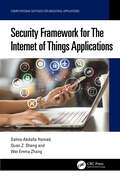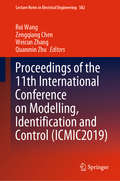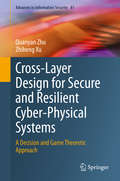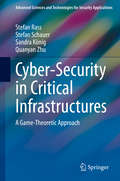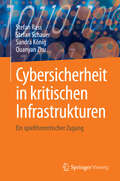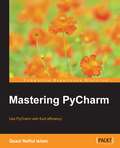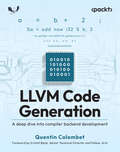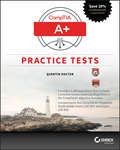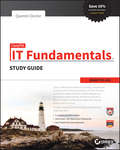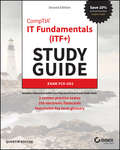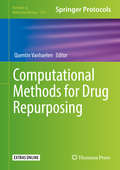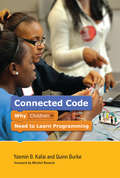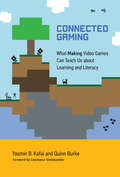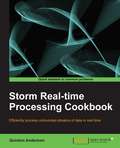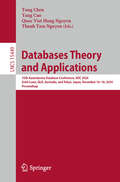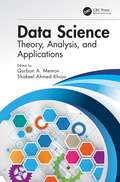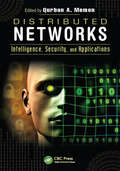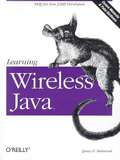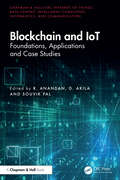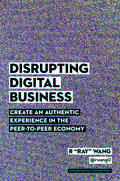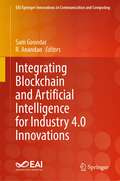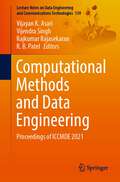- Table View
- List View
Security Framework for The Internet of Things Applications (Computational Methods for Industrial Applications)
by Quan Z. Sheng Wei Emma Zhang Salma Abdalla HamadThe text highlights a comprehensive survey that focuses on all security aspects and challenges facing the Internet of Things systems, including outsourcing techniques for partial computations on edge or cloud while presenting case studies to map security challenges. It further covers three security aspects including Internet of Things device identification and authentication, network traffic intrusion detection, and executable malware files detection.This book: Presents a security framework model design named Behavioral Network Traffic Identification and Novelty Anomaly Detection for the IoT Infrastructures Highlights recent advancements in machine learning, deep learning, and networking standards to boost Internet of Things security Builds a near real-time solution for identifying Internet of Things devices connecting to a network using their network traffic traces and providing them with sufficient access privileges Develops a robust framework for detecting IoT anomalous network traffic Covers an anti-malware solution for detecting malware targeting embedded devices It will serve as an ideal text for senior undergraduate and graduate students, and professionals in the fields of electrical engineering, electronics and communication engineering, computer engineering, and information technology.
Proceedings of the 11th International Conference on Modelling, Identification and Control (Lecture Notes in Electrical Engineering #582)
by Rui Wang Zengqiang Chen Weicun Zhang Quanmin ZhuThis book includes original, peer-reviewed research papers from the 11th International Conference on Modelling, Identification and Control (ICMIC2019), held in Tianjin, China on July 13-15, 2019. The topics covered include but are not limited to: System Identification, Linear/Nonlinear Control Systems, Data-driven Modelling and Control, Process Modelling and Process Control, Fault Diagnosis and Reliable Control, Intelligent Systems, and Machine Learning and Artificial Intelligence.The papers showcased here share the latest findings on methodologies, algorithms and applications in modelling, identification, and control, integrated with Artificial Intelligence (AI), making the book a valuable asset for researchers, engineers, and university students alike.
Cross-Layer Design for Secure and Resilient Cyber-Physical Systems: A Decision and Game Theoretic Approach (Advances in Information Security #81)
by Quanyan Zhu Zhiheng XuThis book introduces a cross-layer design to achieve security and resilience for CPSs (Cyber-Physical Systems). The authors interconnect various technical tools and methods to capture the different properties between cyber and physical layers. Part II of this book bridges the gap between cryptography and control-theoretic tools. It develops a bespoke crypto-control framework to address security and resiliency in control and estimation problems where the outsourcing of computations is possible. Part III of this book bridges the gap between game theory and control theory and develops interdependent impact-aware security defense strategies and cyber-aware resilient control strategies.With the rapid development of smart cities, there is a growing need to integrate the physical systems, ranging from large-scale infrastructures to small embedded systems, with networked communications. The integration of the physical and cyber systems forms Cyber-Physical Systems (CPSs), enabling the use of digital information and control technologies to improve the monitoring, operation, and planning of the systems. Despite these advantages, they are vulnerable to cyber-physical attacks, which aim to damage the physical layer through the cyber network.This book also uses case studies from autonomous systems, communication-based train control systems, cyber manufacturing, and robotic systems to illustrate the proposed methodologies. These case studies aim to motivate readers to adopt a cross-layer system perspective toward security and resilience issues of large and complex systems and develop domain-specific solutions to address CPS challenges.A comprehensive suite of solutions to a broad range of technical challenges in secure and resilient control systems are described in this book (many of the findings in this book are useful to anyone working in cybersecurity). Researchers, professors, and advanced-level students working in computer science and engineering will find this book useful as a reference or secondary text. Industry professionals and military workers interested in cybersecurity will also want to purchase this book.
Cyber-Security in Critical Infrastructures: A Game-Theoretic Approach (Advanced Sciences and Technologies for Security Applications)
by Quanyan Zhu Stefan Rass Stefan Schauer Sandra KönigThis book presents a compendium of selected game- and decision-theoretic models to achieve and assess the security of critical infrastructures. Given contemporary reports on security incidents of various kinds, we can see a paradigm shift to attacks of an increasingly heterogeneous nature, combining different techniques into what we know as an advanced persistent threat. Security precautions must match these diverse threat patterns in an equally diverse manner; in response, this book provides a wealth of techniques for protection and mitigation. Much traditional security research has a narrow focus on specific attack scenarios or applications, and strives to make an attack “practically impossible.” A more recent approach to security views it as a scenario in which the cost of an attack exceeds the potential reward. This does not rule out the possibility of an attack but minimizes its likelihood to the least possible risk. The book follows this economic definition of security, offering a management scientific view that seeks a balance between security investments and their resulting benefits. It focuses on optimization of resources in light of threats such as terrorism and advanced persistent threats. Drawing on the authors’ experience and inspired by real case studies, the book provides a systematic approach to critical infrastructure security and resilience. Presenting a mixture of theoretical work and practical success stories, the book is chiefly intended for students and practitioners seeking an introduction to game- and decision-theoretic techniques for security. The required mathematical concepts are self-contained, rigorously introduced, and illustrated by case studies. The book also provides software tools that help guide readers in the practical use of the scientific models and computational frameworks.
Cybersicherheit in kritischen Infrastrukturen: Ein spieltheoretischer Zugang
by Quanyan Zhu Stefan Rass Stefan Schauer Sandra KönigDieses Buch stellt ein Kompendium ausgewählter spiel- und entscheidungstheoretischer Modelle zur Erreichung und Bewertung der Sicherheit kritischer Infrastrukturen vor. Angesichts aktueller Berichte über Sicherheitsvorfälle verschiedenster Art lässt sich ein Paradigmenwechsel hin zu immer heterogeneren Angriffen erkennen. Hierbei werden verschiedene Techniken kombiniert werden, was zu einer fortgeschrittenen, anhaltenden Bedrohung führen kann. Sicherheitsvorkehrungen müssen diesen vielfältigen Bedrohungsmustern in ebenso vielfältiger Weise gerecht werden. Als Antwort darauf bietet dieses Buch eine Fülle von Techniken zum Schutz vor und zur Abschwächung von IT-Angriffen. Ein Großteil der traditionellen Sicherheitsforschung konzentriert sich auf bestimmte Angriffsszenarien oder Anwendungen und ist bestrebt, einen Angriff "praktisch unmöglich" zu machen. Ein neueres Sicherheitskonzept betrachtet die Sicherheit als ein Szenario, in dem die Kosten eines Angriffs den möglichen Nutzen übersteigen. Dies schließt die Möglichkeit eines Angriffs nicht aus, sondern minimiert die Wahrscheinlichkeit eines solchen auf das geringstmögliche Risiko. Das Buch folgt dieser ökonomischen Definition von Sicherheit und bietet eine managementwissenschaftliche Sichtweise, die ein Gleichgewicht zwischen Sicherheitsinvestitionen und dem daraus resultierenden Nutzen anstrebt. Es konzentriert sich auf die Optimierung von Ressourcen angesichts von Bedrohungen wie Terrorismus und fortgeschrittenen, anhaltenden Bedrohungen. Ausgehend von der Erfahrung der Autoren und inspiriert von realen Fallstudien bietet das Buch einen systematischen Ansatz für die Sicherheit und Widerstandsfähigkeit kritischer Infrastrukturen. Das Buch ist eine Mischung aus theoretischer Arbeit und praktischen Erfolgsgeschichten und richtet sich vor allem an Studenten und Praktiker, die eine Einführung in spiel- und entscheidungstheoretische Techniken für die Sicherheit suchen. Die erforderlichen mathematischen Konzepte sind in sich abgeschlossen, werden rigoros eingeführt und durch Fallstudien illustriert. Das Buch bietet auch Software-Tools, die den Leser bei der praktischen Anwendung der wissenschaftlichen Modelle und Berechnungsrahmen unterstützen. Dieses Buch ist eine Übersetzung einer englischen Originalausgabe. Die Übersetzung wurde mit Hilfe von künstlicher Intelligenz (maschinelle Übersetzung durch den Dienst DeepL.com) erstellt. Eine anschließende menschliche Überarbeitung erfolgte vor allem in Bezug auf den Inhalt, so dass sich das Buch stilistisch anders liest als eine herkömmliche Übersetzung.
Mastering PyCharm
by Quazi Nafiul IslamUse PyCharm with fluid efficiency to write idiomatic python codeAbout This BookUnderstand how PyCharm works and how you can leverage its strength to develop applications quicklyMaster PyCharm's editor to get a fast workflowFull of examples and illustrations that focus on the practical aspects of using PyCharmWho This Book Is ForIf you know PyCharm but want to understand it better and leverage its more powerful but less obvious tool set, this is the book for you. Serving as a launch pad for those who want to master PyCharm and completely harness its best features, it would be helpful if you were familiar with some of Python's most prominent tools such as virtualenv and Python's popular docstring formats such as reStructuredText and EpyType.What You Will LearnUnderstand the internal workings of the IntelliJ PlatformLeverage PyCharm's powerful search tools, and learn which ones are the best for you and your workflowCustomize PyCharm's enhanced Python interpreter and its inbuilt terminalDevelop web applications quickly and easily with different frameworks such as Flask and DjangoUnderstand how code completion works in PyCharm for Python and JavaScriptMake calls to external tools, and use PyCharm macros to your advantageIn DetailPyCharm is addictive, with powerful and configurable code completion, superb editing tools, top-notch support, diverse plugins, and a vibrant ecosystem to boot. Learning how PyCharm works and maximising the synergy of its powerful tools will help you to rapidly develop applications.From leveraging the power of the editor to understanding PyCharm's internals, this book will give you a comprehensive view of PyCharm and allow you to make your own choices about which workflow and tools are best for you.You will start by getting comfortable with PyCharm and making it look exactly like you want. You can customize the tools and taskbars to suit individual developers' coding styles. You also learn how to assign keyboard shortcuts. You will master debugging by inserting breakpoints, collecting runtime data, and debugging from the console. You will understand how PyCharm works underneath and how plugins such as Codemap, Vim, Bitbucket, Assets compressor, markdown, bash file, shortcut translator, and .gitignore leverage the power of the IntelliJ platform.You will become comfortable using the VCS interface in PyCharm and see the benefits of using it for some simple tasks as well as some more complex tasks such as partial commits using changelists.You will take an in-depth look at the various tools in PyCharm, improving your workflow drastically. Finally, you will deploy powerful PyCharm tools for Django, Flask, GAE, and Pyramid Development, becoming well acquainted with PyCharm's toolset for web development with popular platforms.Packed with insider tricks, this book will help you boost productivity with PyCharm.Style and approachAn easy-to-follow guide with plenty of examples and screenshots. Each topic starts off with the goal of enhancing or changing a part of PyCharm to make it suit your needs.
LLVM Code Generation: A deep dive into compiler backend development
by Quentin ColombetExplore the world of code generation with the LLVM infrastructure, and learn how to extend existing backends or develop your ownKey FeaturesUnderstand the steps involved in generating assembly code from LLVM IRLearn the key constructs needed to leverage LLVM for your hardware or backendStrengthen your understanding with targeted exercises and practical examples in every chapterPurchase of the print or Kindle book includes a free PDF eBookBook DescriptionThe LLVM infrastructure is a popular compiler ecosystem widely used in the tech industry and academia. This technology is crucial for both experienced and aspiring compiler developers looking to make an impact in the field. Written by Quentin Colombet, a veteran LLVM contributor and architect of the GlobalISel framework, this book provides a primer on the main aspects of LLVM, with an emphasis on its backend infrastructure; that is, everything needed to transform the intermediate representation (IR) produced by frontends like Clang into assembly code and object files. You’ll learn how to write an optimizing code generator for a toy backend in LLVM. The chapters will guide you step by step through building this backend while exploring key concepts, such as the ABI, cost model, and register allocation. You’ll also find out how to express these concepts using LLVM's existing infrastructure and how established backends address these challenges. Furthermore, the book features code snippets that demonstrate the actual APIs. By the end of this book, you’ll have gained a deeper understanding of LLVM. The concepts presented are expected to remain stable across different LLVM versions, making this book a reliable quick reference guide for understanding LLVM.What you will learnUnderstand essential compiler concepts, such as SSA, dominance, and ABIBuild and extend LLVM backends for creating custom compiler featuresOptimize code by manipulating LLVM's Intermediate RepresentationContribute effectively to LLVM open-source projects and developmentDevelop debugging skills for LLVM optimizations and passesGrasp how encoding and (dis)assembling work in the context of compilersUtilize LLVM's TableGen DSL for creating custom compiler modelsWho this book is forThis book is for both beginners to LLVM and experienced LLVM developers. If you’re new to LLVM, it offers a clear, approachable guide to compiler backends, starting with foundational concepts. For seasoned LLVM developers, it dives into less-documented areas such as TableGen, MachineIR, and MC, enabling you to solve complex problems and expand your expertise. Whether you’re starting out or looking to deepen your knowledge, this book has something for you.
CompTIA A+ Practice Tests: Exam 220-901 and Exam 220-902
by Quentin DocterBring your A game to the CompTIA A+ Certification exam Practice tests are an excellent way for certification candidates to prepare for taking exams, and the well-crafted questions and detailed answers you'll find inside will help give you the confidence to succeed on exam day. With 100% coverage of Exam 220-901 and Exam 220-902 objectives from hardware and networking to mobile devices and Windows operating systems, CompTIA A+ Practice Tests help you gauge your readiness — and hone your test-taking strategy — well in advance of exam day. Designed to measure a candidate's competency with various hardware components and software operating systems, the A+ certification is the most popular entry-level IT certification around. CompTIA A+ Practice Tests provides nine unique practice tests—totaling 1,020 questions—that cover the nine CompTIA A+ objective domains you'll encounter in Exam 220-901 and Exam 220-902. Plus, the book includes two additional 90-question practice exams (180 questions total). That's 1,200 practice test questions in all! You will also gain access to the Sybex interactive learning environment where you have access to all questions, and can create your own practice tests based on areas where further review is needed. Practice questions provide comprehensive coverage of the exam objectives An excellent study companion for anyone renewing their certification or taking it for the first time The 1,200 practice questions are organized into nine full-length tests Complements the CompTIA A+ Complete Study Guide Practice tests are among the most effective exam prep tools, practice with Sybex so you can be confident on exam day.
CompTIA IT Fundamentals Study Guide
by Quentin DocterInformation Technology is not just about what applications you can use; it is about the systems you can support. The CompTIA IT Fundamentals certification is an introduction to the skills required to become a successful systems support professional, progressing onto more advanced certifications and career success. The Sybex CompTIA IT Fundamentals Study Guide covers 100% of the exam objectives in clear and concise language and provides you authoritatively with all you need to know to succeed in the exam. Along with gaining preventative maintenance skills, you will also develop the tools to complete troubleshooting and fault resolution and resolve common issues experienced by the majority of computer systems. The exam focuses on the essential IT skills and knowledge needed to perform tasks commonly performed by advanced end-users and entry-level IT professionals alike, including: Identifying and explaining computer components Setting up a workstation, including conducting software installations Establishing network connectivity Identifying compatibility issues and identifying and preventing security risks Managing the safety and preventative maintenance of computers Practical examples, exam highlights and review questions provide real-world applications and uses. The book includes Sybex's interactive online learning environment and test bank with an assessment test, chapter tests, flashcards, and a practice exam. Our study tools can help you prepare for taking the exam???and increase your chances of passing the exam the first time!
CompTIA IT Fundamentals Study Guide: Exam FC0-U61
by Quentin DocterThe ultimate study guide for the essential entry-level IT cert! The CompTIA IT Fundamentals Study Guide: Exam FC0-U61, Second Edition is your ideal companion for comprehensive exam preparation. Covering 100 percent of the latest exam objectives, this book contains everything you need to know to pass with flying colors—the first time! Clear, concise language breaks down fundamental IT concepts to help you truly grasp important concepts, and practical examples illustrate how each new skill is applied in real-world situations. You’ll learn your way around hardware and software, conduct installations, and connect to networks to get a workstation up and running smoothly; you’ll also develop the knowledge base needed to identify compatibility and security issues, mitigate risks, and conduct all-important preventative maintenance that keeps the end-user problem-free. The CompTIA IT Fundamentals certification validates your skills as a systems support specialist, and gets your foot in the door to a successful IT career. This book is your ultimate preparation resource, with expert guidance backed by online tools to take your preparation to the next level! Master 100 percent of Exam FC0-U61 objectives Learn real-world applications and practical on-the-job skills Know what to expect with exam highlights and review questions Access online study tools including flashcards, chapter tests, a practice exam, and more! The IT department is instrumental in keeping any organization on its feet. As support staff, you will be called upon to assess and repair common problems, set up and configure workstations, address individual issues, and much more. If you decide to continue on to more advanced IT positions, the CompTIA IT Fundamentals certification is a great springboard; if you’re ready to launch your career, the CompTIA IT Fundamentals Study Guide offers complete, practical prep to help you face the exam with confidence.
Computational Methods for Drug Repurposing (Methods in Molecular Biology #1903)
by Quentin VanhaelenThis detailed book explores techniques commonly used for research into drug repurposing, a well-known strategy to find alternative indications for drugs which have already undergone toxicology and pharma-kinetic studies but have failed later stages during the development, via computational methods. Thereby, it addresses the intense challenges of identifying the appropriate type of algorithm and relevant technical information for computational repurposing. Written for the highly successful Methods in Molecular Biology series, the authors of each chapter use their experience in the field to describe the implementation and successful use of a specific repurposing method thus providing lab-ready instruction. Authoritative and practical, Computational Methods for Drug Repurposing serves as an ideal guide to researchers interested in this vital area of drug development.
Connected Code: Why Children Need to Learn Programming (The John D. and Catherine T. MacArthur Foundation Series on Digital Media and Learning)
by Yasmin B. Kafai Quinn BurkeWhy every child needs to learn to code: the shift from “computational thinking” to computational participation.Coding, once considered an arcane craft practiced by solitary techies, is now recognized by educators and theorists as a crucial skill, even a new literacy, for all children. Programming is often promoted in K-12 schools as a way to encourage “computational thinking”—which has now become the umbrella term for understanding what computer science has to contribute to reasoning and communicating in an ever-increasingly digital world.In Connected Code, Yasmin Kafai and Quinn Burke argue that although computational thinking represents an excellent starting point, the broader conception of “computational participation” better captures the twenty-first-century reality. Computational participation moves beyond the individual to focus on wider social networks and a DIY culture of digital “making.”Kafai and Burke describe contemporary examples of computational participation: students who code not for the sake of coding but to create games, stories, and animations to share; the emergence of youth programming communities; the practices and ethical challenges of remixing (rather than starting from scratch); and the move beyond stationary screens to programmable toys, tools, and textiles.
Connected Gaming: What Making Video Games Can Teach Us about Learning and Literacy (The John D. and Catherine T. MacArthur Foundation Series on Digital Media and Learning)
by Yasmin B. Kafai Quinn BurkeHow making and sharing video games offer educational benefits for coding, collaboration, and creativity.Over the last decade, video games designed to teach academic content have multiplied. Students can learn about Newtonian physics from a game or prep for entry into the army. An emphasis on the instructionist approach to gaming, however, has overshadowed the constructionist approach, in which students learn by designing their own games themselves. In this book, Yasmin Kafai and Quinn Burke discuss the educational benefits of constructionist gaming—coding, collaboration, and creativity—and the move from “computational thinking” toward “computational participation.” Kafai and Burke point to recent developments that support a shift to game making from game playing, including the game industry's acceptance, and even promotion, of “modding” and the growth of a DIY culture. Kafai and Burke show that student-designed games teach not only such technical skills as programming but also academic subjects. Making games also teaches collaboration, as students frequently work in teams to produce content and then share their games with in class or with others online. Yet Kafai and Burke don't advocate abandoning instructionist for constructionist approaches. Rather, they argue for a more comprehensive, inclusive idea of connected gaming in which both making and gaming play a part.
She Memes Well: Essays
by Quinta Brunson&“In She Memes Well, Quinta gives more than a peek behind the curtain. She invites us in, lets us poke around and offers a balm for our aching souls. She moves beyond the jokes into something much deeper, something we may not recognize we need. She is the friend, sister, lover, cool co-worker we all wished we had.&”—Gabrielle Union, actress and New York Times bestselling author of We&’re Going to Need More Wine From comedian Quinta Brunson comes a deeply personal and funny collection of essays about trying to make it when you're struggling, the importance of staying true to your roots, and how she's redefined humor online. Quinta Brunson is a master at breaking the internet. Before having any traditional background in media, her humorous videos were the first to go viral on Instagram&’s platform. From there, Brunson&’s wryly observant POV helped cement her status in the comedy world at large, with roles on HBO, Netflix, ABC, Adult Swim, BuzzFeed, the CW, and Comedy Central. Now, Brunson is bringing her comedic chops to the page in She Memes Well, an earnest, laugh-out-loud collection about this unusual road to notoriety. In her debut essay collection, Quinta applies her trademark humor and heart to discuss what it was like to go from a girl who loved the World Wide Web to a girl whose face launched a thousand memes. With anecdotes that range from the ridiculous—like the time she decided to go clubbing wearing an outfit she describes as "Gary Coleman meets metrosexual pirate"—to more heartfelt material about her struggles with depression, Quinta's voice is entirely authentic and eminently readable. With its intimate tone and hilarious moments, She Memes Well will make you feel as if you're sitting down with your chillest, funniest friend.
Storm Real-Time Processing Cookbook
by Quinton AndersonA Cookbook with plenty of practical recipes for different uses of Storm.If you are a Java developer with basic knowledge of real-time processing and would like to learn Storm to process unbounded streams of data in real time, then this book is for you.
Databases Theory and Applications: 35th Australasian Database Conference, ADC 2024, Gold Coast, QLD, Australia, December 16–18, 2024, Proceedings (Lecture Notes in Computer Science #15449)
by Yang Cao Tong Chen Quoc Viet Hung Nguyen Thanh Tam NguyenThis LNCS volume constitutes the referred proceedings of 35th Australasian Database Conference, ADC 2024, held in Gold Coast, QLD, Australia, during December 16-18, 2024. The 38 full papers included in these proceedings were carefully reviewed and selected from 90 submissions. They focus on latest advancements and innovative applications in database systems, data-driven applications, and data analytics.
Data Science: Theory, Analysis and Applications
by Qurban A. Memon Shakeel Ahmed KhojaThe aim of this book is to provide an internationally respected collection of scientific research methods, technologies and applications in the area of data science. This book can prove useful to the researchers, professors, research students and practitioners as it reports novel research work on challenging topics in the area surrounding data science. In this book, some of the chapters are written in tutorial style concerning machine learning algorithms, data analysis, information design, infographics, relevant applications, etc. The book is structured as follows: • Part I: Data Science: Theory, Concepts, and Algorithms This part comprises five chapters on data Science theory, concepts, techniques and algorithms. • Part II: Data Design and Analysis This part comprises five chapters on data design and analysis. • Part III: Applications and New Trends in Data Science This part comprises four chapters on applications and new trends in data science.
Distributed Networks: Intelligence, Security, and Applications
by Qurban A. MemonFor many civilian, security, and military applications, distributed and networked coordination offers a more promising alternative to centralized command and control in terms of scalability, flexibility, and robustness. It also introduces its own challenges. Distributed Networks: Intelligence, Security, and Applications brings together scientific research in distributed network intelligence, security, and novel applications. The book presents recent trends and advances in the theory and applications of network intelligence and helps you understand how to successfully incorporate them into distributed systems and services. Featuring contributions by leading scholars and experts from around the world, this collection covers: Approaches for distributed network intelligence Distributed models for distributed enterprises, including forecasting and performance measurement models Security applications for distributed enterprises, including intrusion tackling and peer-to-peer traffic detection Future wireless networking scenarios, including the use of software sensors instead of hardware sensors Emerging enterprise applications and trends such as the smartOR standard and innovative concepts for human–machine interaction in the operating room Several chapters use a tutorial style to emphasize the development process behind complex distributed networked systems and services, which highlights the difficulties of knowledge engineering of such systems. Delving into novel concepts, theories, and advanced technologies, this book offers inspiration for further research and development in distributed computing and networking, especially related to security solutions for distributed environments.
Learning Wireless Java
by Qusay MahmoudLearning Wireless Java is for Java developers who want to create applications for the Micro Edition audience using the Connected, Limited Device Configuration and the Mobile Information Device Profile (MIDP). These APIs specifically for devices such as mobile phones and pagers, allowing programmers to create MIDlet applications. This book offers a solid introduction to J2ME and MIDP, including the javax.microedition classes, as well as classes surrounding the features of the various platforms that the J2ME
Wireless Java
by Qusay MahmoudLearning Wireless Java is for Java developers who want to quickly come up to speed and create applications for the Micro Edition audience. This book covers the Connected, Limited Device Configuration and the Mobile Information Device Profile (MIDP), both currently available from Javasoft. The CLDC contains APIs for small devices that are constrained by both memory and processing power. MIDP builds on top of the CLDC and adds APIs specifically for devices such as mobile phones and pagers, allowing programmers to create MIDlet applications. This book offers a solid introduction to J2ME and MIDP, including an explanation of the J2ME Wireless Toolkit, the MIDlet lifecycle methods, the Java application manager, and the CLDC and MIDP constraints. In addition, we cover the javax.microedition.io, javax.microedition.rms, javax.microedition.lcdui, and javax.microedition.midlet classes, as well as the modified java.lang, java.io, and java.util classes. Discussion centers around building safe, compact applications with the sophisticated graphical interface, database, and networking capabilities that the J2ME supports. In addition, this book also shows you how to download your applications to the latest J2ME-enabled devices, including the Motorola i50x and i85s phones and upgraded Palm handhelds.
Blockchain and IoT: Foundations, Applications and Case Studies (Chapman & Hall/CRC Internet of Things)
by R Anandan, D Akila, and Souvik PalThis book offers a detailed exploration of the transformative potential of the Internet of Things (IoT) and Blockchain in reshaping industries. Through a combination of theoretical foundations, practical case studies, and innovative applications, it highlights how these cutting-edge technologies can revolutionise business models, enhance operational efficiency, and foster innovation. This is a helpful guide for scholars, researchers, and professionals engaged in research on the Internet of Things, Artificial Intelligence, Machine Learning, Blockchain, and their applications at the industry level. Explains how IoT devices can leverage Blockchain technology to enhance security, transparency, and efficiency in data management and transactions Explores the security challenges faced by IoT devices and how Blockchain can address these challenges by providing a decentralised and tamper-resistant platform for data exchange and storage Investigates the potential of cloud-based IoT platforms, analytics, protocols, and business models and renovate the workforce with Industry revolution Discusses how companies can leverage the data generated by IoT devices securely through Blockchain-based data marketplaces Provides real-world examples and case studies of successful implementations of IoT and Blockchain technologies across different industries such as healthcare, manufacturing, logistics, and energy
Disrupting Digital Business
by R Ray" WangWe are no longer an economy of products and services. The digital transformation demands that we focus our attention on experiences and outcomes. Business leaders and their organizations must shift to keeping promises-no matter how their customers interact with them.But organizations no longer control the conversation. In this era of social and mobile technology, customers, employees, suppliers, and partners are in direct communication with one another. Those personal networks and the brands they're passionate about influence their decision making and their spending.The workforce has changed too. Employees expect to be able to determine when and how they will work, the technology they'll use, and the values their company will espouse.Organizations can take part in this conversation only if they recognize how and where it's happening. Resisting these changes will leave executives, managers, and their companies powerless. Organizations must pivot with and ahead of these social, organizational, and technological shifts or risk being left behind.Technology guru Ray Wang shows how organizations can surf the waves of change-how they can keep their promises. Current trends, when taken seriously, require a new way of thinking about business that includes five key areas:1. Consumerization of technology and the new C-suite2. Data's influence in driving decisions3. Digital marketing transformation4. The future of work5. Matrix commerceDigital disruption has changed how we do our work. But by mastering these trends you'll delight your customers with every interaction.
Integrating Blockchain and Artificial Intelligence for Industry 4.0 Innovations (EAI/Springer Innovations in Communication and Computing)
by Sam Goundar R. AnandanThis book discusses the convergence of artificial intelligence (AI) and Blockchain and how they can work together to help reach the goals of Industry 4.0. The authors first discuss how AI and Blockchain can help increase performance in business. The authors go on to discuss how the technologies can integrate to provide a competitive edge for businesses through improvements in big data, which has allowed firms to organize huge datasets into structured components that computers can process quickly. The authors also cover security implications and how AI and Blockchain can act as a double-edged sword against cyber-attacks. Impacts in programming, calculations, robotization, robots, and equipment are also discussed. This book caters to an extensive cross-sectional and multi-disciplinary readership. Academics, researchers and their students in topics such as artificial intelligence, cyber-physical systems, ethics, robotics, safety engineering, and safety-critical systems should find the book of value.
Computational Methods and Data Engineering: Proceedings of ICCMDE 2021 (Lecture Notes on Data Engineering and Communications Technologies #139)
by Vijendra Singh Vijayan K. Asari R. B. Patel Rajkumar RajasekaranThe book features original papers from International Conference on Computational Methods and Data Engineering (ICCMDE 2021), organized by School of Computer Science and Engineering, Vellore Institute of Technology, Vellore, Tamil Nadu, India, during November 25–26, 2021. The book covers innovative and cutting-edge work of researchers, developers, and practitioners from academia and industry working in the area of advanced computing.
Computational Methods and Data Engineering: Proceedings of ICMDE 2020, Volume 1 (Advances in Intelligent Systems and Computing #1227)
by Sanjay Kumar Vijendra Singh Vijayan K. Asari R. B. PatelThis book gathers selected high-quality research papers from the International Conference on Computational Methods and Data Engineering (ICMDE 2020), held at SRM University, Sonipat, Delhi-NCR, India. Focusing on cutting-edge technologies and the most dynamic areas of computational intelligence and data engineering, the respective contributions address topics including collective intelligence, intelligent transportation systems, fuzzy systems, data privacy and security, data mining, data warehousing, big data analytics, cloud computing, natural language processing, swarm intelligence, and speech processing.
